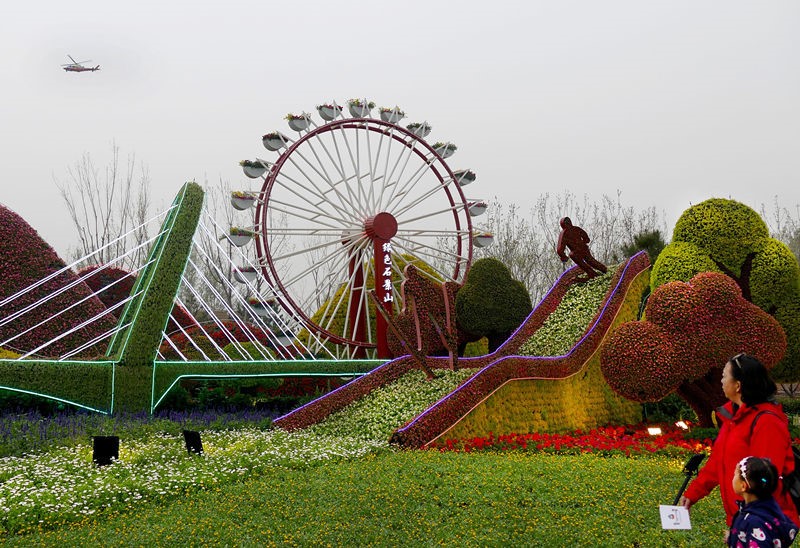

The upcoming Beijing International Horticultural Exhibition will feature a series of new technologies and is hailed by organizers and experts as a signal of China’s confidence and openness in communicating its green development strategy.

On April 20th, the Beijing Shiyuanhui Park conducted a full-load stress test with more than 60,000 visitors. (Photo by Li Wenming from People’s Daily Online)
Eighty-six countries and regions, as well as 24 international organizations, will display horticulture arts alongside domestic exhibitors from 31 provincial-level administrations, Jiang Zehui, vice director of the organizing committee of the expo, said at a conference on April 24.
The expo will open on April 29, and lasts until the first week of October, when the People’s Republic of China celebrates its 70th birthday.
The 162-day expo is anticipated to see 16 million visits and 2,500 activities including academic conferences, horticulture competitions and flower parades, Gao Yan, chairwoman of China Council for the Promotion of International Trade and an organizer of the expo, said at the press conference.
The wide participation and variety of activities demonstrate that China has the confidence to tell the world about its ecological ideals and progress, Gao said.
Wang Qiyan, director of China’s Leisure Economy Research Center under the Renmin University of China, told the Global Times that the expo is a great opportunity for different countries and regions to share their experience in ecological protection and promote further cooperation in building a green Belt and Road Initiative.
Various activities will feature horticulture from different parts of the world to emphasize the expo’s theme “Live green, live better,” which reflects a traditional Chinese philosophy that people are an integral part of the nature, Jiang, also president of the China Flower Association, said at the press conference on April 24.
The expo should be a dialogue between nature and human beings, she said.
The horticultural expo is also a scientific event as major exhibition halls will be covered by 5G networks.
A mobile app designed for the expo will offer information about transportation, accommodation and interesting activities to visitors, cutting waiting time and reducing congestion.
The app also teaches users about trees, flowers and horticulture, the Science and Technology Daily reported.
Visitors will be served by robotic docents, coffee makers and cleaners.
One highlight is a magic forest that uses augmented reality technologies to reveal creatures from ancient legends, the Xinhua News Agency reported.
Construction and decoration of exhibition halls have been finished, and the cultivation of plants is ongoing with the help of the organizer.
Parking lots and public transportation have been arranged to support the expected crowds, said Vice Mayor of Beijing Wang Hong.
Customs, plant quarantine authorities and the forestry bureau have cooperated closely to accelerate the approval of plants’ entry and exit, said the State Forestry and Grassland Administration.
 Fire brigade in Shanghai holds group wedding
Fire brigade in Shanghai holds group wedding Tourists enjoy ice sculptures in Datan Town, north China
Tourists enjoy ice sculptures in Datan Town, north China Sunset scenery of Dayan Pagoda in Xi'an
Sunset scenery of Dayan Pagoda in Xi'an Tourists have fun at scenic spot in Nanlong Town, NW China
Tourists have fun at scenic spot in Nanlong Town, NW China Harbin attracts tourists by making best use of ice in winter
Harbin attracts tourists by making best use of ice in winter In pics: FIS Alpine Ski Women's World Cup Slalom
In pics: FIS Alpine Ski Women's World Cup Slalom Black-necked cranes rest at reservoir in Lhunzhub County, Lhasa
Black-necked cranes rest at reservoir in Lhunzhub County, Lhasa China's FAST telescope will be available to foreign scientists in April
China's FAST telescope will be available to foreign scientists in April "She power" plays indispensable role in poverty alleviation
"She power" plays indispensable role in poverty alleviation Top 10 world news events of People's Daily in 2020
Top 10 world news events of People's Daily in 2020 Top 10 China news events of People's Daily in 2020
Top 10 China news events of People's Daily in 2020 Top 10 media buzzwords of 2020
Top 10 media buzzwords of 2020 Year-ender:10 major tourism stories of 2020
Year-ender:10 major tourism stories of 2020 No interference in Venezuelan issues
No interference in Venezuelan issues
 Biz prepares for trade spat
Biz prepares for trade spat
 Broadcasting Continent
Broadcasting Continent Australia wins Chinese CEOs as US loses
Australia wins Chinese CEOs as US loses